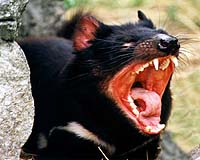| . |  |
. |
Cambridge, UK (SPX) May 26, 2009 Researchers at the Universities of Cambridge and Queen Mary, University of London have found that rooks, a member of the crow family, are capable of using and making tools, modifying them to make them work and using two tools in a sequence. The results are published on-line this week in the journal Proceedings of the National Academy of Sciences. "This finding is remarkable because rooks do not appear to use tools in the wild, yet they rival habitual tools users such as chimpanzees and New Caledonian crows when tested in captivity," said Chris Bird, the lead author of the study. In a series of experiments, the rooks quickly learnt to drop a stone to collapse a platform and acquire a piece of food, and subsequently showed the ability to choose the right size and shape of stone without any training. Not only could they use stones to solve the task, but they were flexible in their tool choice, using and modifying sticks to achieve the same goal. When the correct tool was out of reach, they used another tool to get it, demonstrating the ability to use tools sequentially. In further tests, the rooks were able to use a hook tool to get food out of a different tube and even creatively bent a straight piece of wire to make the hook to reach the food. "We suggest that this is the first unambiguous evidence of animal insight because the rooks made a hook tool on their first trial and we know that they had no previous experience of making hook tools from wire because the birds were all hand-raised," said Dr Nathan Emery, Queen Mary University of London, in whose lab these experiments were performed. These findings suggest that rooks' ability to use tools and represent the tools' useful properties may be a by-product of a sophisticated form of physical intelligence, rather than tool use having evolved as an adaptive specialisation, such as has been proposed for the tool using abilities of New Caledonian crows. This work was carried out at the University of Cambridge by Christopher Bird, a PhD student, and his supervisor, Dr. Nathan Emery from Queen Mary University of London and was funded by the Royal Society, the BBSRC and the University of Cambridge.
Share This Article With Planet Earth
Related Links University of Cambridge Darwin Today At TerraDaily.com
 Australia's Tasmanian devil declared endangered
Australia's Tasmanian devil declared endangeredSydney (AFP) May 22, 2009 Australia's Tasmanian devil, the world's largest surviving marsupial carnivore, will be listed as endangered because of a contagious and deadly cancer, the government said Friday. "This disease has led to the decline of about 70 percent of the Tasmanian devil population since the disease was first reported in 1996," Environment Minister Peter Garrett said in a statement. Devil facial tum ... read more |
|
| The content herein, unless otherwise known to be public domain, are Copyright 1995-2009 - SpaceDaily. AFP and UPI Wire Stories are copyright Agence France-Presse and United Press International. ESA Portal Reports are copyright European Space Agency. All NASA sourced material is public domain. Additional copyrights may apply in whole or part to other bona fide parties. Advertising does not imply endorsement,agreement or approval of any opinions, statements or information provided by SpaceDaily on any Web page published or hosted by SpaceDaily. Privacy Statement |